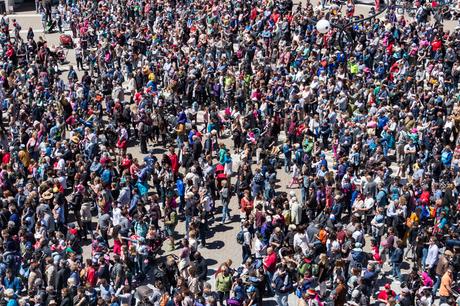
Governor JB Pritzker said he is asking President Joe Biden and the federal government to increase Illinois' share of federal funding to reflect the results of a recent Census Bureau study showing the state was likely underestimated in the 2020 census.
"Updated census data indicates that Illinois has passed 13 million people for the first time in history," he said. "Adjusted census results show an increase in Illinois' population as people move into the state in search of economic and job opportunities."
Meanwhile, the Illinois Democrats' congressional delegation wrote directly to the Census Bureau asking how the survey data will be used, warning: "Any federal entity disregarding the revised estimate of Illinois population to determine these funding allocations could have serious consequences for those affected by such underfunding".
While there's nothing wrong with a state governor or congressman trying to maximize federal resources for their state - they do it all the time as part of their job - one thing should be clear: the official 2020 census figures released last August have not been changed.
They have not been "adjusted", "updated" or "revised".
Anyone who goes to the Census Bureau website to look up the population of Illinois in the 2020 census will find the number reported in August of about 12.8 million, not the 13 million and more that many people are now claiming. .
"Consistent with our past practice, we will not adjust census counts for apportionment or redistricting," Census Bureau statistician Timothy Kennel said during a press briefing last week. "The post-census survey is a probability survey of approximately 161,000 housing units in approximately 10,000 blocks across the country which is independent of the census operation."
But Pritzker and congressional Democrats are not trying to win back the US House seat that Illinois lost this year. They are concerned about Illinois' share of about $1.5 trillion in federal funding that is disbursed to state and local governments based on formulas that use census data.
Pritzker's claims, along with those of many others, are based on the release last week of Census Bureau post-census survey data, which showed the state could have earned as much as $250,000. inhabitants since the 2010 census.
This was newsworthy because the actual census showed a population loss of about 18,000, or 0.1%. And even that was a much smaller loss than many expected.
Based on data collected in this survey, Illinois was among six states that had "statistically significant" undercounts in the 2020 census, while eight states had statistically significant overcounts.
Without going into too much detail about the science of sampling and margins of error, let's try to understand exactly what the Census Bureau did.
After each decennial census, office officials travel to the field to conduct a follow-up survey. This year, they randomly selected 161,000 households - out of approximately 127 million occupied dwellings in the country - and sent occupants a survey questionnaire, asking them essentially the same questions as those on the census form: names , ages and demographic profile of each. occupant of the household.
After subtracting all vacant structures, group dwellings and households that did not respond to the survey from the sample, they ended up with a sample of approximately 114,000 households nationwide. From there, they compared the information on the survey form with the information submitted during the actual 2020 count.
However, like any random sample survey, the postcensal survey is subject to a margin of sampling error.
In this case, the Illinois undercount was estimated at 1.97%. This would mean that the state's population that was reported in the 2020 census was only 98.03% of what it should have been, based on the survey.
But statisticians like to express these kinds of numbers in terms of "confidence intervals." In this case, that means they can say "with 90% confidence" that the undercount could have been as large as 3.43%, or as low as 0.51%.
So how could this have happened?
There are many possibilities and the postcensal survey does not even try to answer the question. Some people forget to fill in the census form or fill it in incorrectly. Some may not report everyone living in their household, and others may add people who are staying there temporarily while their current residence is being repaired.
Another possibility unique to 2020 is that students who were enrolled in out-of-state schools but were forced to return home when campuses were closed due to the pandemic were counted as living at home then that, in a normal year, they would have counted where they attended school.
Another important thing to note about census data is that the two operations - the actual census and the post-censal survey - are separate and independent of each other. The survey is not a complement or a correction of the census itself.
So why does the Census Bureau do it?
"These 2020 census coverage estimates help us understand the quality of the 2020 census and will inform our plans for the 2030 census," Kennel said.
Indeed, the U.S. Supreme Court ruled in 1999 that the Constitution and federal law prohibit the Census Bureau from using statistical sampling data to adjust Congressional allocation, although this decision says nothing about the allocation of federal funds.
But that could raise some tricky political issues, because if you urge the Biden administration to allocate funds based on population estimates from a survey, rather than the actual census, that would not only increase funding for states under -counted, but would also reduce funding for over-counted states.

